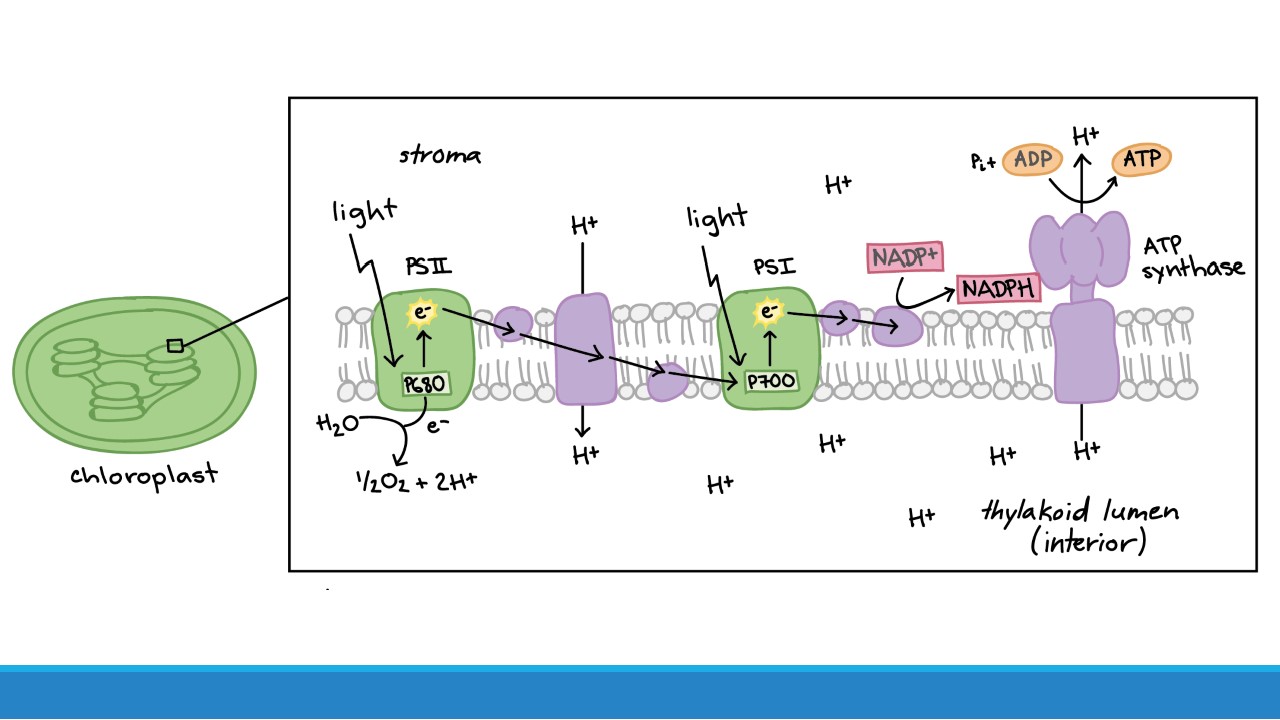Photosynthesis
1/6
There's no tags or description
Looks like no tags are added yet.
Name | Mastery | Learn | Test | Matching | Spaced |
|---|
No study sessions yet.
7 Terms
Stroma
Fluid in which light independent reactions take place, second part of photosynthesis
Thylakoid
- contains pigments for light dependent photosynthesis, contains enzymes for this (first part of photosynthesis). Thylakoids made of membrane
Stages of photosynthesis
Photosynthesis is split into two stages
The light dependent reaction, which occurs in the thylakoid membranes
The light independent reaction, which occurs in the stroma
The light independent stage can occur in the absence of light however it requires producings produced in the light dependent stage
The light dependent reaction has two main parts
Production of ATP
Photolysis of water

Production of ATP
The thylakoid membranes contain the proteins and enzymes needed for the
light dependent reaction
The membranes contain two trans-membrane complexes called
photosystems I and ll. They are made of proteins and photosynthetic
pigments.
PSII mostly absorbs light of 680 nm
PSI mostly absorbs light of 700 nm
When light is absorbed by chlorophyll in PSII, a pair of electrons are excited
to a higher energy level — they leave the chlorophyll molecule.
The electrons are passed through a series of electron carrier molecules (also
found in thylakoid membrane) in a series of oxidation-reduction reactions
These carrier molecules form an electron transport chain. Energy is lost as
the electrons are passed from one carrier to the next.
This energy is used to produce ATP from ADP and Pi through chemiosmosis
Photosystem I also forms part of the electron transport chain
Production of ATP - Chemiosmosis
Uses proton pumps (proteins) in the thylakoid membrane
H + ions (protons) are pumped from the stroma into the thylakoid lumen against
their concentration gradient - requires energy released from the electron
transport chain
This maintains a high concentration of H + ions in the thylakoid lumen
The H + ions then move by diffusion across the thylakoid membrane back into the
stroma. They pass through the ATP synthase channel protein.
H + causes structural changes to the ATP synthase enzyme, activating it to catalyse
the formation of ATP: ADP + Pi ATP
ATP is needed for the light independent reaction (second stage of photosynthesis).
Photolysis of water
Photolysis = splitting of water using light energy
Water is split into oxygen, hydrogen ions and electrons:
The electrons replace those lost from photosystem Il — Why is this
important?
When PSII absorbs light, it excites electrons to a higher energy level.
These excited electrons leave PSII and move down the electron transport chain to eventually help make energy molecules (ATP and NADPH).
Once those electrons leave, PSII is left missing electrons—kind of like a battery that has lost its charge.
To continue absorbing light and exciting more electrons, PSII must replace the lost electrons. Otherwise, it can't pass on energy anymore because it has no electrons left to excite.
H+ contributes to the high concentration inside the thylakoid lumen — it can
then diffuse through the ATP synthase channel protein
What happens to the oxygen?
The oxygen atoms from water combine to form O₂ gas (molecular oxygen).
This oxygen is released as a byproduct of photosynthesis.
It diffuses out of the thylakoid and eventually leaves the plant cell into the atmosphere.
This is the oxygen that we and other aerobic organisms breathe!
Production of reduced NADP
NADP is an electron carrier molecule and the final molecule in the electron
transport chain
NADP is reduced by H+ and electrons to form reduced NADP (NADPH)
NADP++ + 2e-» NADPH +
Reduced NADP, along with ATP, is needed for the next stage of
photosynthesis: the light independent reaction